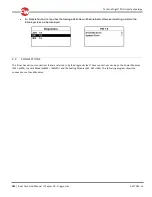
SK77981-14
192 | R-net Technical Manual | Chapter 10 – Diagnostics
Curtiss-Wright | PG Drives Technology
4.3
DRIVE TEST
With the maximum speed control in the minimum position, drive the wheelchair in all directions, ensuring the drive is
comfortable and easy to control for the user.
Repeat the above but with the speed control set to maximum.
4.4
GRADIENT TEST
NOTE:
Before carrying out this test ensure another person is present to prevent the wheelchair from tipping backwards.
Drive the wheelchair forwards up its maximum rated gradient. While on the gr adient release the joystick and ensure the
wheelchair comes to rest and the brakes are applied without the front wheels lifting of the ground.
Deflect the joystick forwards and continue driving up the slope. Ensure the pick up is smooth and positive.
Stop the wheelchair and reverse down the gradient. While on the gradient release the joystick and ensure the wheelchair
comes to rest and the brakes are applied without the front wheels lifting off the ground.
4.5
LIGHTS, INDICATORS AND HAZARD LAMPS TEST
If lights are fitted:
Visually check each bulb for correct illumination.
Check each indicator bulb for correct illumination and that the flash rate is 1.5Hz ± 0.5Hz.
Disconnect each bulb in turn and check that the remaining bulb for that side flashes at 3Hz ± 0.5Hz.
If hazard lamps are fitted:
Check each bulb for correct illumination and that the flash rate is 1.5Hz ± 0.5Hz.
4.6
ACTUATOR TEST
If actuators are fitted:
Check each motor for correct direction of movement.
Ensure the mechanical end-stops are secure and that they stall the actuator motors, thus operating the ISM’s
automatic end-stop detection.
4.7
INHIBIT INPUT TEST
Insert an appropriate battery charger, or equivalent inhibit connection, into the Charger Connector on the JSM and ensure that
drive is inhibited.
If Inhibits 2, 3, 4 and 5 are used for inhibit or speed limiting purposes, suitable tests should be devised to ensure correct
operation.















































